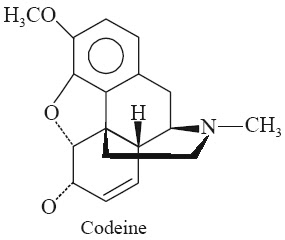B. Codeine
Synonyms Codicept; Morphine monomethyl ether; Morphine 3-methyl ether; Methylmorphine.
Biological Sources It is obtained from the plant Argemone mexicana L. (Papaveraceae) (Prickly Poppy); Eschscholzia california Cham. (Papaveraceae) (California Poppy); Papaver bracteatum Lindl. (Papaveraceae) (Great scarlet poppy, Thebaine Poppy); and Papaver somniferum L. (Papaveraceae) (Opium Poppy, Poppyseed Poppy Keshi).
Chemical Structure
(5α, 6α)-7, 8-Didehydro-4, 5-epoxy-3-methoxy-17-methyl-morphinan-6-ol; (C18H21NO3).
Preparation It is invariably present in opium from 0.7 to 2.5% depending on the sources of plant substances. However, mostly it is prepared by carrying out the methylation of morphine.
Characteristic Features
1. It is obtained as monohydrate orthorhombic sphenoidal rods or tablets (octahedra) from water or dilute ethanol having mp 154-156°C (after drying at 80°C).
2. It is found to sublime (when anhydrous) at 140-145°C under 1.5 mm reduced pressure.
3. It is observed to melt to oily drops when heated in an amount of water is sufficient for complete solution, and subsequently crystallizes on cooling.
4. Its physical parameters are: d420 1.32; [α]D15 -1360 (C = 2 in ethanol); [α]D15 – 112o (C = 2 in chloroform); pK (15°) 6.05; pH of a saturated solution 9.8.
5. Solubility Profile: 1 g dissolves in 120 ml water, 60 ml water at 80°C, 2 ml ethanol, 1.2 ml hot ethanol, 13 ml benzene, 18 ml ether, 0.5 ml chloroform; freely soluble in methanol, dilute acids and amyl alcohol; and almost insoluble in solutions of alkali hydroxides and in petroleum ether.
Identification Test It forms various types of salts, namely:
1. Codeine Acetate (C20H25NO5): The dihydrate is obtained as crystals having an acetic acid odour. It is found to be soluble in water and ethanol. It loses acetic acid on keeping and subsequently turns into a product which is incompletely soluble in water.
2. Codeine Hydrobromide (C18H21NO3.HBr): The dihydrate is obtained as crystals and the anhydrous product shows a mp 190-192°C; [α ]D22 – 96.60 ; 1 g dissolves in 60 ml water, 110 ml ethanol; and pH about 5.
3. Codeine Hydrochloride (C18H21NO3.HCl): Its dihydrate salt is obtained as small needles having mp ~ 280°C with some decomposition; [α ]D22 -1080 ; 1 g dissolves in 20 ml of water, 1 ml boiling water, 180 ml ethanol; and pH about 5.
4. Codeine Salicylate (C25H27NO6): It is obtained as white crystalline powder; slightly soluble in water; and freely soluble in ethanol or ether.
5. Codeine Phosphate (C18H24NO7P) (Galcodine): The hemihydrate salt (USP) is obtained as fine, white, needle-shaped crystals or crystalline powder. It is odorless and affected by light. The solution is acidic to litmus. It is freely soluble in water; very soluble in hot water; slightly soluble in ethanol; and more soluble in boiling ethanol.
6. Codeine Sulphate (C36H44N2O10S): The trihydrate is obtained as crystals or crystalline powder; 1 g dissolves in 30 ml water; 6.5 ml water at 80°C; 1300 ml ethanol; insoluble in chloroform or ether; pH 5.0.
7. Codeine Methyl Bromide (C19H24Br-NO3) (Eucodin) : Its crystals have mp ~ 260°C; soluble in 2-3 parts of water, in hot methanol; sparingly soluble in ethanol; and insoluble in chloroform and ether.
Uses
1. It is mostly used as a narcotic analgesic.
2. It is invariably employed as an antitussive.
Source:Pharmacognosy And Pharmacobiotechnology By Ashutosh Kar
Source:Pharmacognosy And Pharmacobiotechnology By Ashutosh Kar



0 Comment:
Post a Comment